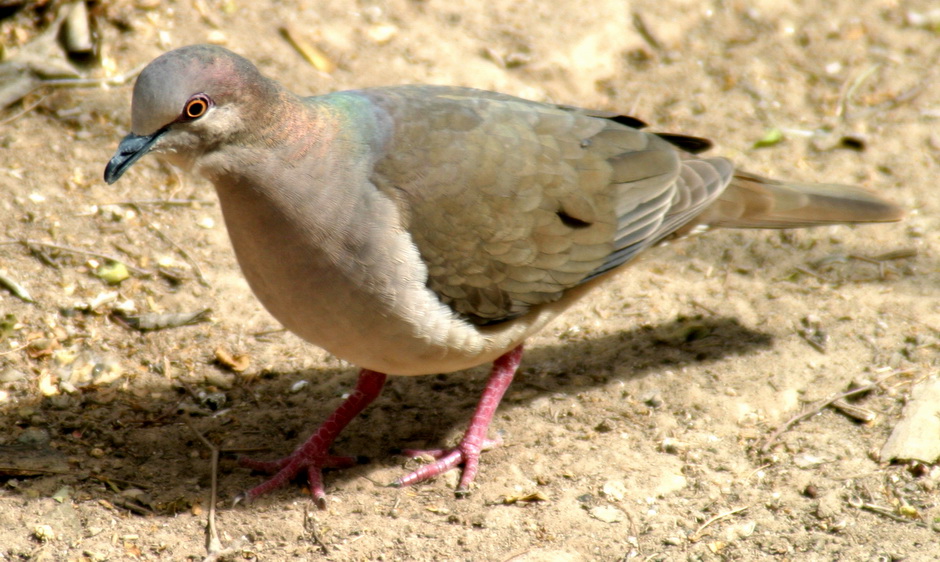| New Photos | Animal News | Animal Sounds | Animal Movies | Upload Photo | Copyright | Korean |
|---|
| Funny Animal Photos | Monsters in Animalia | Wiki Articles Fun Facts about Animals | Links | Home | Mobile A.P.A. |
|---|
| Image Info | Original File Name: White-tipped Dove (Leptotila verreauxi).jpg Resolution: 940x562 File Size: 235270 Bytes Date: 2006:03:04 15:20:28 Camera: Canon EOS 10D (Canon) F number: f/5.6 Exposure: 1/250 sec Focal Length: 200/1 Upload Time: 2007:10:29 14:46:25 | |
| Author | Name (E-mail): Unknown | |
| Subject | White-tipped Dove (Leptotila verreauxi) - Wiki | |
 |
| Email : E-Card | Poster | Web Master Delete Edit Info Admin |
| Description | White-tipped Dove (Leptotila verreauxi) - Wiki
White-tipped Dove
The White-tipped Dove (Leptotila verreauxi) is a large New World tropical dove. It is a resident breeder from the southernmost Texas in the USA through Mexico and Central America south to western Peru and central Argentina. It also breeds on the offshore islands of northern South America, including Trinidad and Tobago and the Netherlands Antilles. Numerous subspecies exist; some of the more widespread are the nominate taxon, L. v. verreauxi, from Nicaragua to Venezuela, L. v. angelica from Texas and coastal Mexico, L. v. decolor west of the Andes from Colombia to northern Peru, L. v. brasiliensis in most of the Amazon north of the Amazon River and L. v. decipiens in a large part of central South America. The White-tipped Dove inhabits scrub, woodland and forest. It builds a large stick nest in a tree and lays two white eggs. Incubation is about 14 days, and fledging another 15. The White-tipped Dove has an approx. length of 28 cm (11 in) and a weight of 155 g (5½ oz). Adult birds of most races have a grey tinge from the crown to the nape, a pale grey or whitish forehead and a whitish throat. The eye-ring is typically red in most of its range, but blue in most of the Amazon and northern South America. The upperparts and wings are grey-brown, and the underparts are whitish shading to pinkish, dull grey or buff on the chest. The underwing coverts are rufous. The tail is broadly tipped with white, but this is best visible from below or in flight. The bill is black, the legs are red and the iris is yellow. The White-tipped Dove resembles the closely related Grey-fronted Dove, Leptotila rufaxilla, which prefers humid forest habitats. The best distinctions are the greyer forehead and crown, which contrast less with the hindcrown than in the Grey-fronted Dove. In the area of overlap, the White-tipped Dove usually has a blue (not red) eye-ring, but this is not reliable in some parts of Brazil, Argentina, Bolivia, Paraguay and Uruguay, where it typically is red in both species. The White-tipped Dove is usually seen singly or in pairs, and is rather wary. Its flight is fast and direct, with the regular beats and clattering of the wings which are characteristic of pigeons in general. The food of this species is mainly seeds obtained by foraging on the ground, but it will also take insects, including butterflies and moths. The call is a deep hollow ooo-wooooo. The scientific name of this bird commemorates the French naturalists Jules and Edouard Verreaux. http://en.wikipedia.org/wiki/White-tipped_Dove
| |||
| Copyright Info | AnimmalPicturesArchive.com does not have the copyright for this image. This photograph or artwork is copyright by the photographer or the original artist. If you are to use this photograph, please contact the copyright owner or the poster. |
|
|
|
| |||||||
| CopyLeft © since 1995, Animal Pictures Archive. All rights may be reserved. | ||||||||
Stats